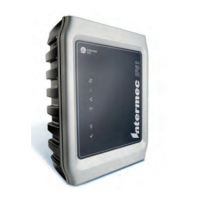Chapter 3 — Developing and Using RFID Applications
54 IF61 Fixed Reader User’s Manual
RFID Applications and the IF61
The IF61 supports Java and C# applications. Your application
communicates with the IF61 through one of two RFID services:
• the Basic Reader Interface (BRI) server, which controls the
reader by issuing BRI commands. For more information on
the BRI server, see “Configuring the BRI Server” on page 69.
For more information on using BRI, see the Basic Reader
Interface Programmer’s Reference Manual (P/N 937-000-xxx).
• the Low-Level Reader Protocol (LLRP), based on the
EPCglobal standard. For more information on LLRP settings,
see “Configuring LLRP Settings” on page 71.
There are two ways to use the IF61 with your RFID application:
• You can run the application on a remote server. In this case,
all processing is performed by the server.
• You can run the application locally on the IF61. In this case,
the application resides on the IF61, and much of the
processing occurs on the IF61 and not remotely on the server.
Running your application on the IF61 improves system
scalability by minimizing network traffic, since the IF61 can
handle many processing tasks such as data filtering.
You can set up your application to auto-start when the IF61
boots. For more information, see “Auto-Starting Applications at
Boot Time” on page 57.
If your application uses the IF61 GPIO interfaces to control
external devices such as indicator lamps, running the application
on the IF61 decreases response time for those devices. For more
information, see Chapter 5, “Using the IF61 GPIO Interfaces.”
Using the RFID Resource Kit
The Intermec Developer Library RFID Resource Kit includes
Java and C# tools you can use to develop applications that enable
control of the reader and data management.
The resource kit is available as part of the Intermec Developer
Library (IDL). To learn more about the RFID Resource Kit, go
to www.intermec.com and choose Products > Applications and
Software > Development Tools > Developer Resource Kits.

